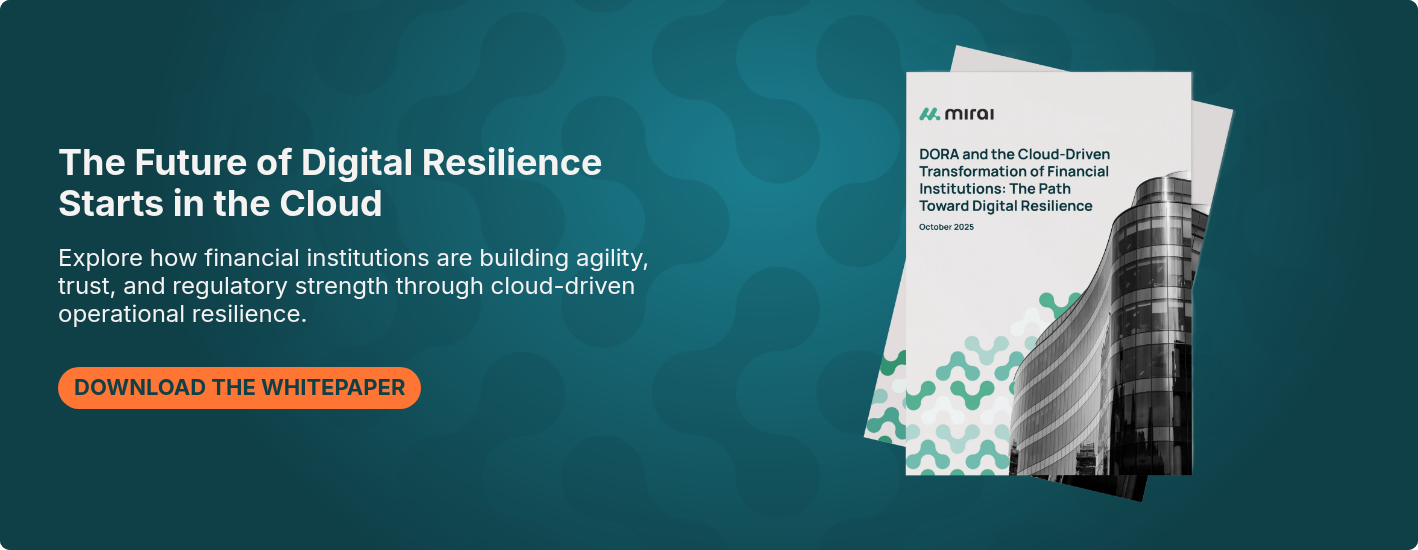Other
From On-Premise to Cloud: How DORA Is Paving the Way to Digital Resilience

By Javier Arranz
November 10, 2025
The Digital Operational Resilience Act (DORA) is not simply a regulation, it reflects a realistic view of how technology, governance, and risk intersect in the financial world. It acknowledges that disruptions are inevitable and that resilience is built not by avoiding failure but by preparing for it.
This mindset is especially visible in the technological transformation currently reshaping the financial sector. As institutions migrate from traditional on-premise infrastructures to cloud environments, DORA provides a framework to ensure that innovation and resilience evolve together, in balance. In this article, we’ll explore how these two environments differ, and how DORA helps financial institutions navigate the transition with confidence.
Audio Article
How These Environments Differ: From On-Premise Control to Cloud Dependency
For decades, the banking system operated under an on-premise model, maintaining direct control over data centers, servers, and infrastructure. This offered a sense of stability but came with constraints: every update required manual intervention, every change implied downtime, and scaling operations demanded new hardware. Agility and innovation were difficult to achieve in such rigid environments.
Cloud computing has fundamentally changed that. Today, institutions can deploy updates in real time, scale resources instantly, and access advanced security services such as IDS/IPS, firewalls, and WAF, directly from providers. These capabilities allow for faster regulatory adaptation and continuous service delivery without interruption.
In practical terms, this transformation offers clear advantages:
- Faster delivery and updates, enabling continuous improvement without downtime.
- Integrated security tools, natively available through cloud or SaaS models.
- Reduced operational burden, with hardware maintenance replaced by predictable service models.
However, it also introduces a new kind of dependency. By transferring physical control to external providers, institutions must now ensure that resilience extends beyond their own infrastructure. Avoiding vendor lock-in becomes essential, and DORA explicitly requires clear exit strategies and assurance that all providers maintain equivalent standards of security and resilience.
The Cultural Shift: From Control to Collaboration Inside the Financial Institutions
Ultimately, more than a technological shift, the move from on-premise to cloud is a structural and cultural one. It changes how institutions think about control, collaboration, and resilience.
Financial institutions must now manage relationships and dependencies with the same rigor once applied to hardware, ensuring that flexibility operates within a framework of governance, compliance, and control. Ownership is no longer defined by physical infrastructure but by oversight, visibility, and trust.
This evolution demands closer coordination between risk, compliance, and technology teams. DORA formalizes this mindset by promoting transparency, shared responsibility, and readiness across the entire financial ecosystem.
It also brings a more realistic understanding of resilience. Incidents will happen—what matters is how institutions respond, recover, and maintain trust. In this sense, resilience becomes a collective habit, built on collaboration, foresight, and a culture that values preparation over perfection.
The Cloud as Both Facilitator and Challenge
The cloud plays a dual role in operational resilience, being both an enabler of agility and a potential source of new dependency.
On one hand, cloud infrastructures provide unprecedented advantages: high availability, geographic redundancy, automated backups, and the ability to redeploy systems in minutes through infrastructure-as-code. These capabilities directly support DORA’s principles of business continuity and rapid recovery.
Cloud environments also allow resources to scale dynamically according to real-time demand, a critical capability in high-volume or variable operational contexts. Cloud platforms provide immediate access to emerging technologies such as AI, machine learning, big data, and IoT, enabling faster innovation cycles.
A cloud-based SaaS infrastructure supports a continuous update model, where new features, security patches, and performance enhancements are deployed seamlessly and transparently. This approach eliminates traditional version cycles and ensures that products evolve in step with regulatory and technological demands, often without downtime. Integration with complementary services and automated deployment processes further reinforce stability, scalability, and innovation.
In Practical Terms, the Advantages of the Cloud Environment Can Be Summarized As:
- Scalability and Flexibility – Cloud environments scale dynamically to meet demand, ensuring consistent performance and capacity growth.
- Agility and Innovation – Immediate access to advanced technologies enables faster development and delivery cycles, aligning with evolving regulatory and business needs.
- Continuous Improvement – Automatic updates and integrations strengthen resilience, keeping systems secure and up to date without service interruptions.
On the other hand, the cloud also introduces dependencies that extend beyond an organization’s direct control. Large-scale reliance on hyperscalers introduces concentration risk: a single failure could affect multiple institutions simultaneously. For this reason, DORA places strong emphasis on avoiding vendor lock-in and maintaining tested exit strategies that ensure operations can continue even if a provider becomes unavailable or changes its terms.
One does not need to be running in two providers at once but must know what to do if the one relied upon disappears. Being cloud-agnostic, therefore, is not about duplicating systems; it is about awareness, documentation, and preparedness. Institutions must map their dependencies, define responsibilities, and regularly test their ability to migrate or recover, ensuring that continuity can be sustained under any scenario.
Resilience by Design and Collaboration Across the Financial Ecosystem
DORA reinforces the principle of resilience by design, building continuity and recovery capabilities from the earliest stages of every technological project. Security and resilience are no longer end-stage controls but core design principles integrated into infrastructure, code, and operations.
This often requires challenging technical convenience in favor of sustainability. Designing across multiple regions, enforcing access segregation, and defining realistic recovery objectives may introduce complexity, but they are essential for long-term stability. In short, resilience is an architectural decision, not a reaction.
At the same time, DORA broadens this idea to include collaboration across the financial ecosystem. Institutions and their service providers are interconnected, and their ability to withstand disruption depends on shared information, transparency, and coordination.
A clear example is the industry’s response to the Log4j vulnerability, when teams collaborated closely to assess exposure, share findings, and mitigate risks together, which is a practice that DORA now formalizes through structured information-sharing channels, mutual incident notifications, and collective threat intelligence.
The regulation also builds upon existing standards such as ISO 27001, reinforcing practices already familiar to mature organizations—including risk management, incident handling, and business continuity—while adding depth through resilience testing and sector-wide intelligence exchange.
For institutions already operating under advanced frameworks, DORA is not a reinvention but an evolution. It formalizes what resilient organizations have been practicing all along: continuous preparedness, collaboration, and transparency.
The Cloud as a New Model of Resilience in Financial Institutions
More than modernization, cloud adoption under DORA is about building resilience into the fabric of technology and governance. It creates a balance between innovation and control, where flexibility is matched by accountability, and speed is tempered by discipline.
Resilience in the DORA era means readiness, not perfection. It is the ability to adapt, recover, and maintain trust when disruptions inevitably occur: the realistic foundation of a stronger, more connected financial ecosystem.
On-Premise vs Cloud: A Visualization
To summarize this transition, the table below highlights the key differences between traditional on-premise environments and modern cloud infrastructures, showing how the shift redefines concepts such as control, scalability, and resilience under DORA’s framework.
| On-Premise Environments | Cloud Environments |
| Full physical control of infrastructure | Physical control transferred to providers via shared responsibility |
| Manual updates and maintenance windows | Rapid releases and automatic updates |
| Limited scalability and flexibility | Elastic scalability according to demand |
| Higher operational and hardware costs | Predictable licensing and service costs |
| Independent management of security controls | Integrated and on-demand security services (IDS/IPS, firewalls, WAF) |
A Cloud-Native Approach to Financial Resilience
Mirai RiskTech was designed as a cloud-native platform from the start, built to leverage the scalability, flexibility, and resilience of cloud environments. Its architecture enables automatic scaling, continuous updates, and seamless delivery of new features and security enhancements, often without downtime.
Operating under strict financial and regulatory standards, it aligns with AWS’s compliance framework, EBA guidelines, and annual reviews including SOC 2 and ISO 27001 certifications. This approach ensures a secure, transparent, and adaptive platform ready to meet DORA’s evolving demands.
Ready to Navigate DORA with Confidence
Download our Whitepaper "DORA and the Cloud-Driven Transformation: The Path Toward Digital Resilience" and gain the insights you need to strengthen your financial institution's digital resilience.
From understanding DORA’s origins to managing third-party risks and preparing for cloud transformation, this guide helps financial institutions turn compliance into a strategic advantage.
👉 Download the full Whitepaper and start building operational resilience by design.
Other articles
Regulatory Reporting
DPM 2.0 and the EBA’s 4.2 Reporting Framework: Key Changes and Strategic Implications for EU Banks
Balance Sheet Management
,Regulation




